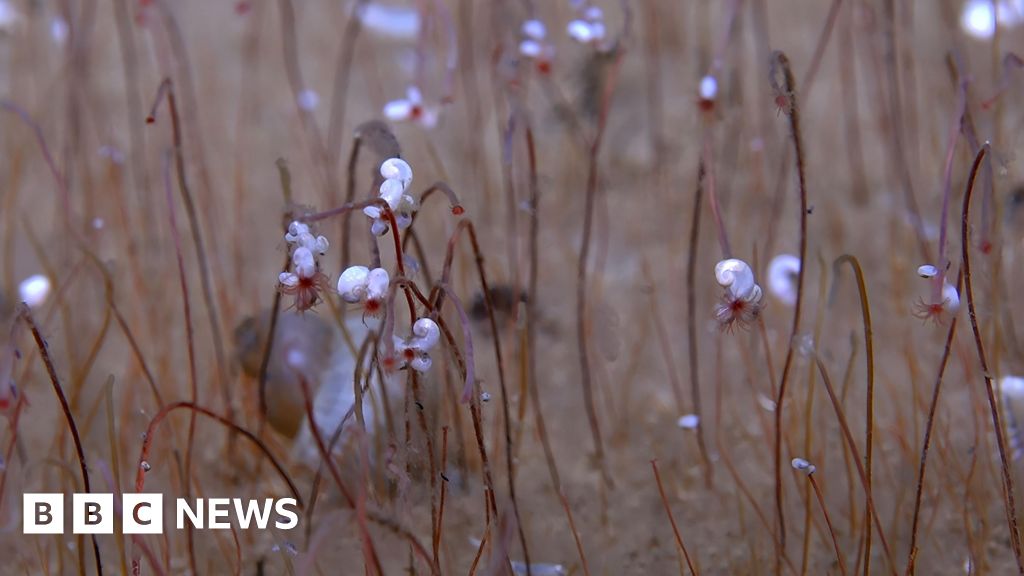
‘Communities’ of strange, extreme life seen for first time in deep ocean
How did your country report this? Share your view in the comments.
Diverging Reports Breakdown
‘Communities’ of strange, extreme life seen for first time in deep ocean
‘Communities’ of strange, extreme life seen for first time in deep ocean trench. Diving in a human-occupied submersible to ocean trenches in northwest Pacific Ocean. Chinese-led research team captured pictures of life at depths of more than 9km (5.6miles) The deepest marine life filmed before this expedition was at 8,336m – a snailfish that was filmed swimming in a deep Ocean trench off the coast of Japan in 2023. With no sunlight, life at these depths is fuelled by chemicals that seep out of the ocean floor. Hydrogen sulfide and methane seep from faults – or cracks – in the Earth’s crust.
18 minutes ago Share Save Victoria Gill Science correspondent, BBC News Share Save
Watch: some of the strange, extreme life filmed at the depths of the ocean
Beds of clams, mats of bacteria that look like ice and fields of tube worms – these are just some examples of the strange, extreme life that an expedition to the deepest parts of the ocean has observed, filmed and photographed. Diving in a human-occupied submersible to ocean trenches in the northwest Pacific Ocean, a Chinese-led research team captured pictures of life at depths of more than 9km (5.6miles). The deepest marine life filmed before this expedition was at 8,336m – a snailfish that was filmed swimming in a deep ocean trench off the coast of Japan in 2023. These new observations are published in the journal Nature.
IDSSE/CAS The scientists photographed what looked like fields of long, thin tube worms
IDSSE/CAS The white, spiky creatures are called Macellicephaloides grandicirra. Here they are photographed in dense colonies of tube worms that can be up to 30cm in length
Although it was accepted among marine scientists that there would be life at these depths, scientists on this mission say the abundance of animals they saw from the windows of their submersible was “amazing”. The scientific expedition covered more than 2,500km – exploring trenches at depths ranging from 5,800 to 9,533m. Researchers travelled in a submersible vehicle called Fendouzhe, which can operate at depths of more than 10km for several hours at a time. The team, led by researchers from the Chinese Academy of Sciences’ Institute of Deep Sea Science and Engineering, discovered what they describe as “thriving communities” of creatures.
IDSSE/CAS The researchers created this composite image of their submersible in a deep ocean trench
“It’s exciting – especially for a deep sea scientist – to go to a place that human beings have not explored,” one of the lead researchers, Dr Xiaotong Peng, told BBC News. “It’s a great opportunity to discover new things. And what we saw was quite amazing.” Scientists photographed and filmed what looked like fields of marine life – dominated by various different types of tube worm and mollusc. These animals live in the pitch dark and under vast pressure. With no sunlight, life at these depths is fuelled by chemicals that seep out of the ocean floor. Hydrogen sulfide and methane seep out of faults – or cracks – in the Earth’s crust. The scientists say they have recorded species never seen before. In future studies, they hope to work out how the bodies of these so called “chemosynthetic” or chemical-fuelled creatures convert these chemicals into energy. “They must [also] have a trick to adapt to life in super high pressure,” added Dr Megran Du, also from China’s Institute of Deep Sea Science and Engineering. “That’s another question we need to answer.”
IDSSE/CAS Beds of molluscs appear to rely on the chemical “fuel” that seeps out of the seabed
Source: https://www.bbc.com/news/articles/c3wnqe5j99do
